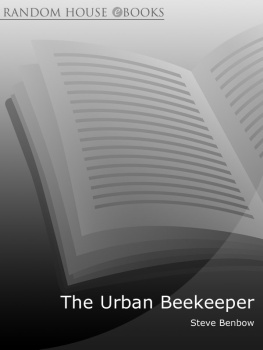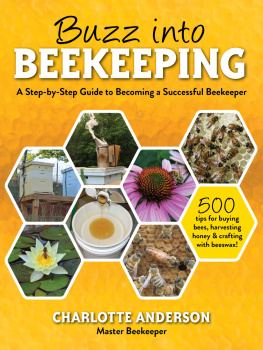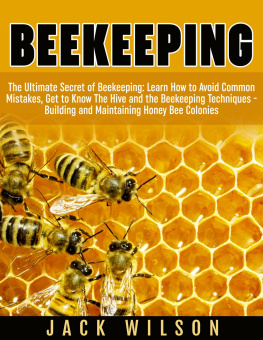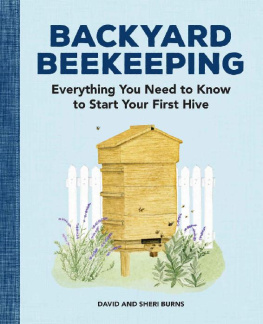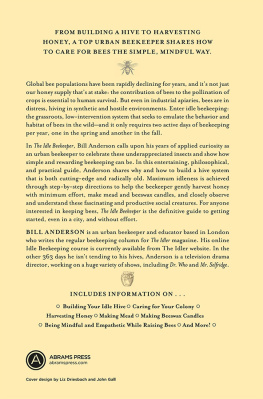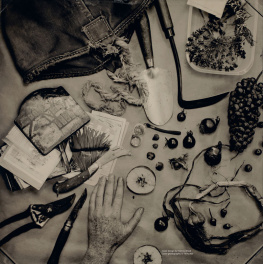CONTENTS
ABOUT THE BOOK
At a time when the UK bee population is in decline theres no better way to make a difference than to start up your own hive. Steve Benbows enormous success with urban beekeeping shows how easy it is to keep bees, whether youre in the city or in the countryside, and youll never look back once youve tasted your very own sticky, golden honey, or lit a candle made from the beeswax from your hive.
Steve Benbow is a visionary beekeeper who started his first bee hive ten years ago on the roof of his tower block in Bermondsey and today runs 30 sites across the city. His bees live atop the Tate Modern and Tate Britain, Fortnum & Mason and the National Portrait Gallery, and he supplies honey to the Savoy tearooms, Harvey Nichols, Harrods and delis across London. His bees forage in parks, cemeteries, along railway lines and in window boxes, and because of the diversity of the plants and trees in the city, produce far richer honey and greater yields than they would in rural areas.
The Urban Beekeeper is a fact-filled diary and practical guide to beekeeping that follows a year in the life of Steve and his bees and shows how keeping bees and making your own delicious honey is something anyone can do. It is a tempting glimpse into a sunlit lifestyle that starts with the first rays of the morning and ends with the warm glow of sunset, filled with oozing honeycomb, natural recipes for sensational honey-based dishes, and honey that tastes like sunshine.
A hugely affectionate but practical diary of a beekeepers year and the immense satisfaction of harvesting your own delicious honey. Read it and join the revolution.
ABOUT THE AUTHOR
Steve Benbow is at the heart of the urban beekeeping revolution. With zero experience he built his first hive on his tower-block rooftop ten years ago. Today, he runs hives across Londons greatest landmarks, including both Tate galleries, Fortnum & Mason, and The National Gallery, as well as hives in Shropshire and Salisbury. He supplies honey to Fortnum & Mason, Harvey Nichols, the Savoy tearooms and Harrods, chefs including Gordon Ramsay and Marcus Wareing, and sells at local farmers markets and from his studio in Bermondsey. He also runs courses in beekeeping.
For Ned
INTRODUCTION
I love everything about bees. Their agile yet languorous flight, their barely audible hum (the snoozy backbeat to a baking summers day) and, of course, their sweet, multi-hued honey. Its still a source of wonder to me that, within a short distance, its flavour can mutate from full-bodied chestnut to sweet lime to silky rose.
Some people might hardly notice these little creatures, but they are everything to me. I adore their varied personalities, admire their magnificent work ethic an average hiveful flies to the moon and back each year and am in awe of their humility. Without their pollination, human life would falter.
My passion for bees was fed by an earlier childhood devotion to insects. I believe it started in a coal bunker, pink, concrete and tucked into the back of my parents Shropshire semi. My secret lair was dark, dry and almost inaccessible to anyone bigger than a skinny little boy in tartan flares with a flash torch, and I was delighted to discover it was also a favourite haunt of the giant house spider.
Row upon row of Robinsons jam jars the glass magnifying the gangly monsters inside were devoted to my collection. I punched crude breathing holes into their metal lids with nails. Each day the spiders were fingered and examined, but with near reverence never harmed, always eventually released.
As my fanaticism for crawly critters grew, my family was encouraged to consume more cosmic-coloured jam, and soon a similar collection was housed on the radiator cover at Long Meadow Junior School. It included winged bees found dead in the school grounds, speared with pins onto bowing cardboard cereal packets. Alongside them sat my collection of cracked birds eggs wrapped in cotton wool.
This classroom was also the location for my first bee sting and no beekeeper ever forgets that. Thinking back, Im certain it was the summer of 1976, the year the country snoozed under a heavy, 20-tog duvet of heat. I was trying to rescue an increasingly distressed honeybee as it struggled to escape through the huge glass windows. The buzzing was a frantic siren call and Id risen from my tiny chair to help.
All the windows were open, but the bee still failed to find its way out. As I cupped my hands around its frantic form, ushering it towards the sunshine and air Id not yet perfected the glass-and-paper routine it delivered its coup de grce.
I can truthfully say that the sting didnt really trouble me. What I was most concerned about was the bees death as its abdomen was torn apart. I didnt react to its injecting of venom into the palm of my hand this seemed more fascinating than sadistic and the pain passed quickly. What I didnt then realise was that this was a good omen for a future career as well as a new member for my cereal-packet pinboard club.
Even at eight years old Id known it was a honeybee. My maternal grandparents had been keeping bees on their Shropshire apple orchard ever since a government initiative to combat sugar shortages in the Second World War. Granddads honey was smooth, dark and sweet, and I loved it on a doorstep of white bloomer.
Id like to claim that my beekeeping skills were lovingly passed down the generations, but there were no cosy fireside chats with this giant of a blacksmith about his mesmerising craft. In fact, the only wise words on the subject I can recall from him were, You should always tell your bees your worries. Its OK, Granddad, I still do.
My paternal grandmother, Grandma Kate, was a formidable midwife who lived on the other side of the county and was also a beekeeper. She was the one who really taught me about bees to start with and a fantastic huge photograph of her and her bees taken in the 1930s is one of my most treasured possessions. I guess she awoke the passion that was lurking dormant somewhere in my DNA.
Over the years my fascination with bees just grew and developed, until one day I woke up to found myself in the strange but wonderful occupation of a full-time beekeeper. This book tells of my adventures along the way, and particularly follows my progress over the year I decided to bring my bees back to London. What I like to call my capital takeover.
By making each chapter a month, Ill show how the beekeepers year pans out the dos and donts, the little secrets, the big mistakes, and the tremendous rewards. I hope my adventures will inspire you to find out more about these marvellous little creatures. Whether youre in the deepest rural shires, heather-clad moors, windswept sea fronts or cluttered city streets (and Ive done them all), the essential skills of beekeeping remain the same.
I guarantee that you will never do anything else in your life which connects you so closely to the changing seasons and the vagaries of nature. Or anything remotely so rewarding and life-enhancing.
JANUARY
HIBERNATION TIME
IN DAYS GONE by, the start of the year would hardly have triggered mass outbreaks of enthusiasm, energy or motivation. As a commercial beekeeper, I would use the post-Christmas lull, not as an opportunity to implement my New Years resolutions and join a gym, but instead for the expansion of my waistline; and for recuperation from having worked flat out to a point of apocalyptic bee exhaustion.
Requests from delis and shops for beautifully packaged urns of lightly coloured glowing honeycombs would have begun to arrive at the start of November and continued all the way until late Christmas Eve. By knocking-off time my fingers would be raw from tying intricate bows, whilst my spirits suffered from perpetual festive blues.
Next page
